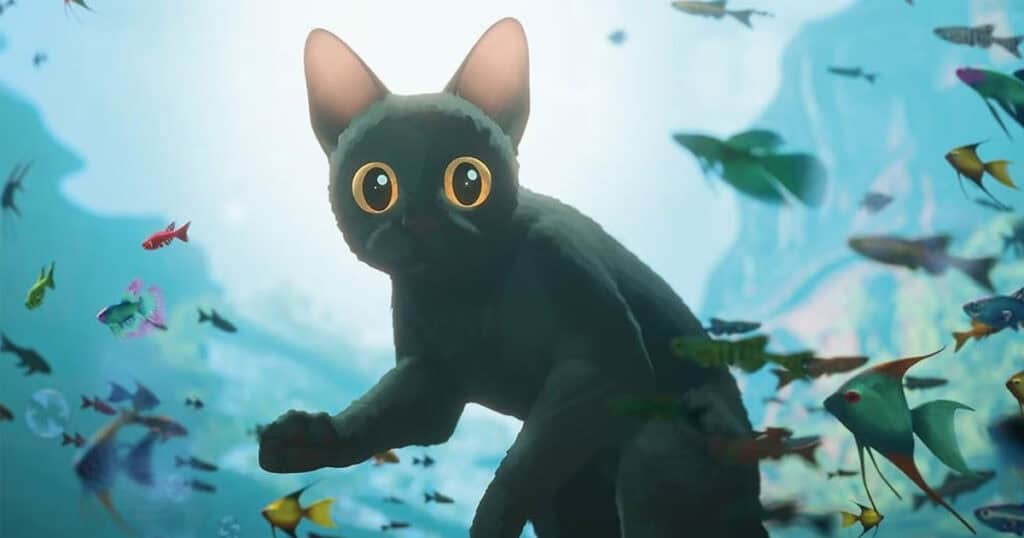Latvian filmmaker Gints Zilbalodis and his team used open-source software to create Flow, one of the year’s best animated epics.

Mother nature is exhausted. Humankind, while innovative, is forever stumbling through evolution, leaving scars on the planet in its wake of misguided greed, hubris, and little consideration for future generations. One day, it could all get washed away in a justified rage. The money won’t save you. We’d have no one to blame but ourselves as we become another bullet point in a tome of the planet’s enduring history. Why walk this dark thought road, anticipating an enema of all we’ve built? It’s where my head is after watching Flow, a brilliant animated meditation on chaos, perseverance, and the strength of community.
Directed by Latvian filmmaker Gints Zilbalodis, Flow is an animated survival epic made entirely with the open-source software Blender. It follows a black cat journeying through a post-cataclysmic world alongside a menagerie of animal friends after a biblical-level flood destroys his home. There is no dialogue throughout the film, a creative choice that puts character, story, and animation above snappy banter, winking double entendre, and third-act apologies as part of a formulaic “all is forgiven” resolution. Flow asks audiences to witness a grand adventure unhindered by celebrity voices and insufferable catchphrases.
Regarding the film’s overall look, Blender helps Zilbalodis and his team build a picturesque world without the bells and whistles of a Pixar, Dreamworks, or Disney production. While Flow‘s presentation can sometimes appear muddy, pixelated, or jagged, its aesthetic is refreshing in an industry continuously striving for perfection. Moreover, the world of Flow is fascinating. Among the ruins of a fallen society are mysterious, towering monuments, forgotten relics, and dilapidated housing that buckles and bends with the wind’s moan. It gives the impression that humans shuffled off the mortal coil long ago and maybe started worshipping cats again, as evidenced by the massive feline statues strewn about the land. We may never know.
As the cat navigates increasingly high flood waters, he gradually collects a group of traveling companions in a wise and lethargic capybara, a covetous and narcissistic ring-tailed lemur, a stoic and protective secretary bird, and an upbeat yellow labrador retriever. The group boards a row boat that provides them with a safe way to travel through the flooded terrain. You can accept the group dynamic as animals tolerating each other to survive or view them as a sub-in for humans. Both interpretations work exceptionally well.
Viewing the cat and his companions as human substitutes adds a layer of complexity to the survival story. Species from different walks of life learn to tolerate one another and work together to navigate unimaginable hardships. There are in-fighting, power struggles, and instances of surrender as each learns to depend on the other for guidance, protection, and optimism about an increasingly dire situation. Flow’s depiction of complex relationships makes the film much more than a Homeward Bound clone or riffs on post-apocalyptic survival like The Walking Dead or The Day After Tomorrow. The expressive animals convey emotion in multitudes, and because of the absence of dialogue, the viewer can interpret the would-be conversations as they see fit. Suddenly, you find yourself in that boat and begin to wonder who you are and your contribution to the group.
Flow is a near-perfect film; my only gripe is its visual aesthetic. At its best, Flow transports audiences into a gorgeously rendered world of devastation and promise. Still, I often found the presentation wanting polish and a better frame rate. To its credit, Flow nails the articulation and mannerisms of its cast to astonishing accuracy, making their actions feel familiar to anyone used to their habits. The film overflows with metaphor, which I always enjoy, lending to an in-depth conversation about its themes and uncanny ability to hold a mirror to humankind’s compassion in the face of tragedy.
Love, tolerance, and strength in numbers will always rise above dissension. Flow knows this and aims to educate others through a gripping story, reflective characters, and remarkable use of unconventional animation tools. If we don’t start respecting the planet, we could find ourselves floating through an ocean of destruction, our homes, hearts, and history destroyed. Let Flow entertain you, but also serve as a warning of things to come if we don’t wise up to the damage done.
Originally published at https://www.joblo.com/flow-review-joblo-2024/





